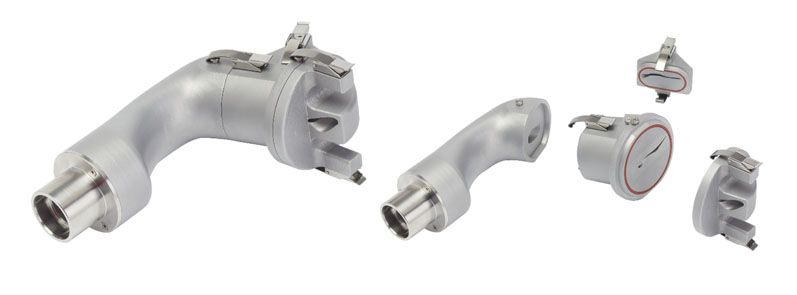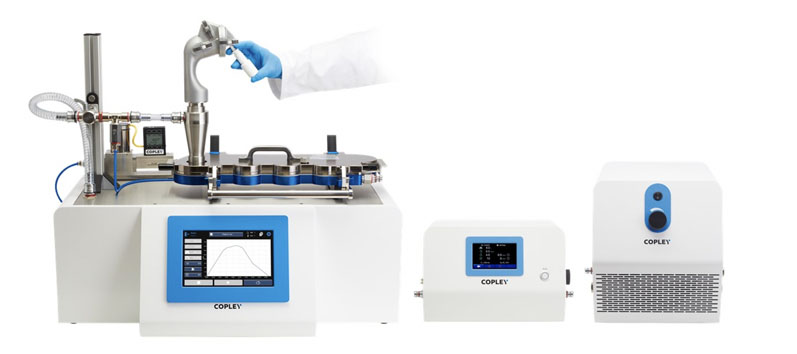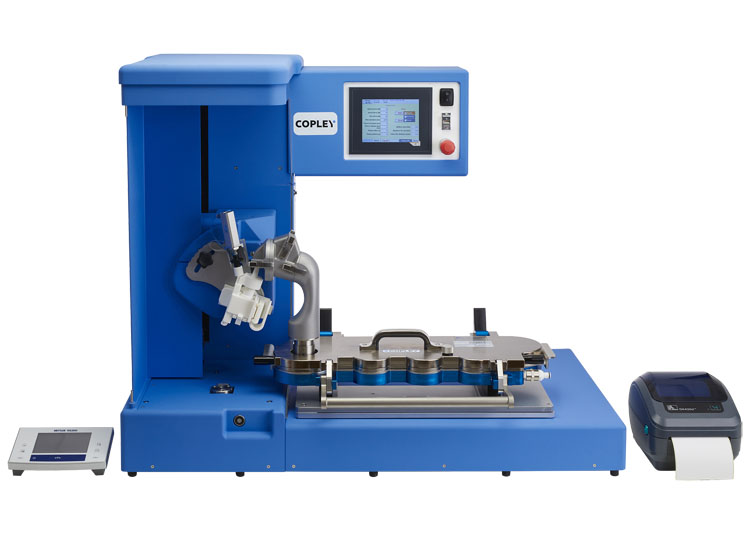However, a list of upcoming product-specific guidance recently released by the US Food and Drug Administration (FDA) includes nasal drug products for the relief of diabetic related-conditions and epileptic seizure clusters, highlighting the extent to which systemic drug delivery via the nasal cavity has become established.1
Nasal delivery for migraine therapies, pain relief and vaccines is also now commonplace with trials of COVID-19 nasal vaccines already under way.2,3

Anna Sipitanou
There is scope to refine the in vitro test methods used for nasal drug products to improve their clinical relevance, to provide more insight for targeted systemic drug delivery and to demonstrate bioequivalence (BE) more rigorously.
In this article, we consider the value of new equipment from Copley Scientific within this context. The global leaders in inhaler testing equipment, Copley has recently implemented a substantial upgrade of its nasal drug product testing equipment to enable smarter, more informative testing in line with evolving market requirements.
Drug delivery via the nose: advantages and challenges
Systemic drug delivery via the nasal cavity eliminates issues associated with passage through the gastrointestinal (GI) tract, providing a way to protect drug molecules that are susceptible to metabolic degradation, such as antigens, and to improve outcomes when GI absorption is compromised for the treatment of conditions such as diabetic gastroparesis.4

Mark Copley
The large area and rich vasculature of the turbinates are the primary target for rapid drug delivery, such as the fast relief of migraine symptoms, whereas the olfactory region at the top of the nasal cavity provides direct access to the central nervous system.5
This route is of particular interest as a way to bypass the blood-brain barrier to deliver drugs for the treatment of neurological illnesses such as Alzheimer’s disease.6
However, as the primary purpose of the nasal airways is to prevent the ingress of hazardous material to the lungs, drug delivery can be challenging. The nasal valve area, which is situated about 2–3 cm into the nose, is the narrowest point in the relatively convoluted geometry of the nasal cavity.7
As such, ensuring that a drug successfully penetrates the turbinates or olfactory region that lies beyond it is a significant hurdle. There is considerable potential for droplets to collect in the anterior cavity and drip from the nostrils — or to pass through the nasopharanyx and be swallowed — leaving an unpleasant aftertaste.
By contrast, fine particles may penetrate the nasal cavity, creating a toxicity risk by entering the body via the lungs. The geometry, aerodynamics and general physiology of the nose makes nasal drug delivery complex and efforts continue to optimise products for all the applications for which it holds promise.
Testing nasal drug products
Nasal drug products can be broadly classified as sprays, aerosols or powders. Mechanical, metered- and/or multidose sprays account for most of the market, although unit-dose devices that avoid the need for preservatives are increasingly popular for drugs such as vaccines.
Nasal aerosols are an alternative device choice for liquid formulations and, like pressurised metered-dose inhalers, use a propellant to aerosolise the dose and drive drug delivery — rather than the hand pump used with nasal sprays.
Commercial nasal powders are less abundant but offer the advantage of preservative-free delivery and can produce long retention times; they are particularly suitable for the delivery of hormones, antigens and peptides. In most cases, dose release is passive and depends on patient inhalation.
When it comes to testing these products, multiple in vitro techniques can be usefully deployed for either new or generic product development.
Examining the product-specific guidance for a metered nasal spray (fluticasone propionate), which details the tests required to demonstrate bioequivalence (BE), provides a useful summary of the most common methods.8 These include
- single actuation content (sometimes alternatively referred to as dose uniformity), which is measured at the beginning and end life stages of the product
- droplet size distribution by laser diffraction (or a validated alternative)
- drug in small particles/droplets by cascade impaction (or a validated, highly sensitive alternative)
- spray pattern
- plume geometry
- priming and repriming.
These tests reflect the need to confirm that a consistent dose is delivered throughout the lifetime of the device, to quantify the size of droplet delivered (as this impacts deposition behaviour), to characterise the evolving spray plume and to measure the amount of drug that could penetrate through to the lung — because of its very fine particle size, which is typically the sub-10 µm fraction, although the absolute cut-off value varies from regulator to regulator.
Testing priming and repriming performance confirms that if the patient uses the product according to the instructions, it will work reliably following storage, for example, or when dropped. It is a reminder of the manual nature of nasal sprays and the potential for patient technique to impact drug delivery.
Enhanced testing (1): a better model of nasal deposition
Better, more routine assessment of nasal deposition underpins efforts to more precisely target and control nasal drug delivery — but can be challenging to implement.
In vivo regional deposition can be studied by gamma scintigraphy, but this is costly and time-consuming; implementing such studies routinely or in the early stages of product development is not practical.9
Alternative strategies include the use of nasal casts and/or computational fluid dynamics, although neither are amenable to routine daily use.

Figure 1: The Alberta Idealised Nasal Inlet representatively mimics averaged adult regional drug deposition across the vestibule, turbinates, olfactory region and nasopharynx (left = closed, right = open)
Building on the success of the now well-established Alberta Idealised Throat(s), the Alberta Idealised Nasal Inlet or AINI (Figure 1) has been developed to improve the clinical relevance of routine in vitro tests without sacrificing simplicity.
Developed by Professor Finlay’s laboratory at the University of Alberta from computer tomography (CT) scans of seven diverse, realistic adult nasal geometries, it enables the representative assessment of regional drug deposition within the nasal cavity.
Extensive numerical simulations were done to model regional nasal deposition within these geometries and the resulting data were then used to design an idealised geometry to robustly mimic averaged deposition.9,10
Under typical test conditions, the refined, clinically validated design representatively measures drug deposition across the vestibule, turbinates, olfactory region and nasopharynx. The AINI is a lightweight, robust accessory that offers
- a simple geometry, mimicking averaged adult deposition while simultaneously producing a representative respirable (sub-10 µm) fraction
- a leak-free design that is readily dismantled to provide access to each of the four regions for drug recovery and assay
- streamlined integration into standard in vitro test set-ups for nasal drug products.
There are two different ways to use the AINI. The first is to simply attach it to an external filter to study regional deposition and representatively measure respirable mass (the fraction of the dose that enters the lungs).
Regional deposition data are generated by breaking the AINI open, after testing, and recovering the drug from each of the constituent parts to quantify deposition in different areas (Figure 1).
This is a cost-efficient way to improve device design to target the olfactory region, for example, and could also be used as a way to demonstrate BE; closely similar regional deposition provides further evidence of comparable drug delivery performance.

Figure 2: Test set-up with the AINI for regional deposition assessment and respirable dose measurement
The second is to interface the AINI with a cascade impactor to enable the representative measurement of the aerodynamic particle size distribution (APSD) of the respirable dose and determine the amount of drug in small particles/droplets with a higher degree of clinical realism.
The AINI can be interfaced with all pharmacopoeia-recommended cascade impactors, including the Andersen Cascade Impactor (ACI) and the Next Generation Impactor (NGI) to improve the integrity of such testing data.
Clearly, the AINI is a simplified representation of the nasal cavity; but, it’s essential for reproducible, routine analysis. In many instances, the primary focus of testing will be to determine the respirable dose; use of the AINI makes such testing more clinically representative without adding unnecessary complexity into the test process.
When the AINI is used to assess regional deposition, its simplicity ensures the analytical sensitivity required to study the four regions of most interest. In either case, the AINI represents an important step forward for nasal drug product testing.
Enhanced testing (2): consistent actuation
The mechanical pump that drives nasal spray drug delivery introduces the potential for variability — either from the actuation or firing technique.
Eliminating this source of analytical variability requires that “a mechanical means of actuating the pump assembly [must] be employed to deliver doses for collection” when testing nasal sprays.11
The Vertus II and Vertus Plus (Figure 3), well-established fully automated flexible shake, fire and flow control systems, can now be used for nasal spray testing to meet this need for highly consistent actuation.
At the same time, they allow researchers to systematically investigate the impact of patient-specific parameters such as shaking or actuation technique. These systems enable the control of
- device shaking prior to actuation (speed, angle and duration)
- the magnitude of any delay between shaking and firing
- the force-time profile applied to the spray pump
- time between repeat firings
- storage conditions during testing (orientation).

Figure 3: Using the Vertus Plus automated shake, fire and flow control system minimises the variability associated with spray actuation while, at the same time, boosting productivity and reducing the health and safety risks associated with testing
The Vertus II/Vertus Plus improves the reproducibility of testing, making it easier to assess the sensitivity of specific devices to technique variability, to tailor devices to target patient populations and to develop products that deliver more robust performance.
Furthermore, systematic studies of the impact of the variables listed helps developers to refine product operating protocols, including storage conditions, and to assess priming and repriming characteristics; for a metered dose spray, complete refilling of the spray chamber is a prerequisite to the successful delivery of a further dose.
In practice, the Vertus II/Vertus Plus is used with a vertically mounted Nasal Spray Dose Collector or Nasal Spray Waste Collector to collect individual doses for analysis or to “fire to waste” under controlled conditions, respectively, in line with regulatory requirements.
These collectors may also be used for manual testing, but automation minimises variability while simultaneously improving productivity and reducing the health and safety risks associated with repeat manual actuation, such as the risk of repetitive strain injury.
Cascade impactor test methods to analyse the respirable fraction can also be improved in a strictly analogous way. Figure 3 shows a test set-up to analyse the sub-10 µm fraction with automated actuation to minimise variability using available accessories, including the AINI.
Looking ahead
There is considerable motivation to further exploit the nasal route for systemic drug delivery, notably for the delivery of drugs to the brain and other specific medicines, such as vaccines. The development of generic nasal drug products for localised action is also an important, current focus.
Refining standard in vitro test methods to improve their in vivo relevance and reduce variability supports these efforts. Copley’s new solutions to test nasal drug products make it easier to bring assessments of regional nasal deposition into routine in vitro measurements, which is helpful for more precise targeting and to provide more robust evidence of BE.
Tools for automated nasal spray actuation, by contrast, not only reduce variability but also lighten the analytical load associated with nasal spray testing, boosting productivity.
Used in combination, these new products help researchers to gather relevant information more cost-efficiently to optimise the application of nasal drug delivery.
References
- www.fda.gov/drugs/guidances-drugs/upcoming-product-specific-guidances-complex-generic-drug-product-development.
- www.ox.ac.uk/news/2021-03-25-university-oxford-study-nasal-administration-covid-19-vaccine.
- https://pharmaphorum.com/news/altimmune-begins-trial-of-nasal-vaccine-for-covid-19.
- www.medscape.com/viewarticle/932857.
- https://touchneurology.com/headache/journal-articles/novel-intranasal-delivery-of-sumatriptan-as-a-route-to-rapid-and-sustained-relief-in-the-acute-treatment-of-migraine-2/#:~:text=The%20benefits%20of%20non%2Doral%20migraine%20therapies&text=Injection%20or%20intranasal%20delivery%20may,risk%20of%20GI%20adverse%20events.
- D. Mittal, et al., “Insights Into Direct Nose to Brain Delivery: Current Status and Future Perspective,” Drug Del. 21(2), 75–86 (2014).
- www.ncbi.nlm.nih.gov/pmc/articles/PMC3539067.
- www.accessdata.fda.gov/drugsatfda_docs/psg/Fluticasone%20propionate%20nasal%20spray%20NDA%20020121%20RV%2002-2019.pdf.
- M. Kiaee, et al., “Regional Deposition of Nasal Sprays in Adults: A Wide-Ranging Computational Study,” Int. J. Numer. Meth. Biomed. Eng. 34, e2968 (2018).
- M. Kiaee, et al., “An Idealized Geometry That Mimics Average Nasal Spray Deposition in Adults: A Computational Study,” Computers in Biology and Medicine 107, 206–217 (2019).
- www.uspbpep.com/usp31/v31261/usp31nf26s1_c601.asp.





